Samsung Galaxy Note 2 Review (T-Mobile) - The Phablet Returns
by Brian Klug on October 24, 2012 9:00 AM ESTCellular
I talked earlier about the Note 2 being the first Samsung handset I know of to include MDM9x15. In the case of the T-Mobile Note 2 I was sampled, the device includes MDM9215 which is capable of category 3 LTE FDD and TDD, Release 9 DC-HSPA+, GSM/EDGE, and TD-SCDMA along with onboard gpsOneGen 8A GNSS. I’ve confirmed that MDM9215 is present without having to disassemble or otherwise tamper with the T-Mobile Galaxy Note 2.
One of the most interesting things about the Galaxy Note 2 on T-Mobile is that it literally is the same hardware as the AT&T Note 2 with LTE. Sure, the model number is different, but the T-Mobile Note 2 includes support for LTE bands 17 (which AT&T uses) and 4 (AWS, which AT&T has specced devices out for and T-Mobile has confirmed it will deploy LTE on). This is to my knowledge the first T-Mobile handset with overt LTE support, and thus a solid future-proof purchase if you’re determined to have a T-Mobile handset that will work with the carrier’s upcoming LTE on AWS plans.
In addition, if you unlock the handset there’s no reason it shouldn’t work on AT&T’s LTE network that I can see. I managed to unlock the T-Mobile Galaxy Note 2 but not before leaving the AT&T LTE market in Dallas. It does however work as expected on WCDMA 1900 in my own market on AT&T after unlocking.
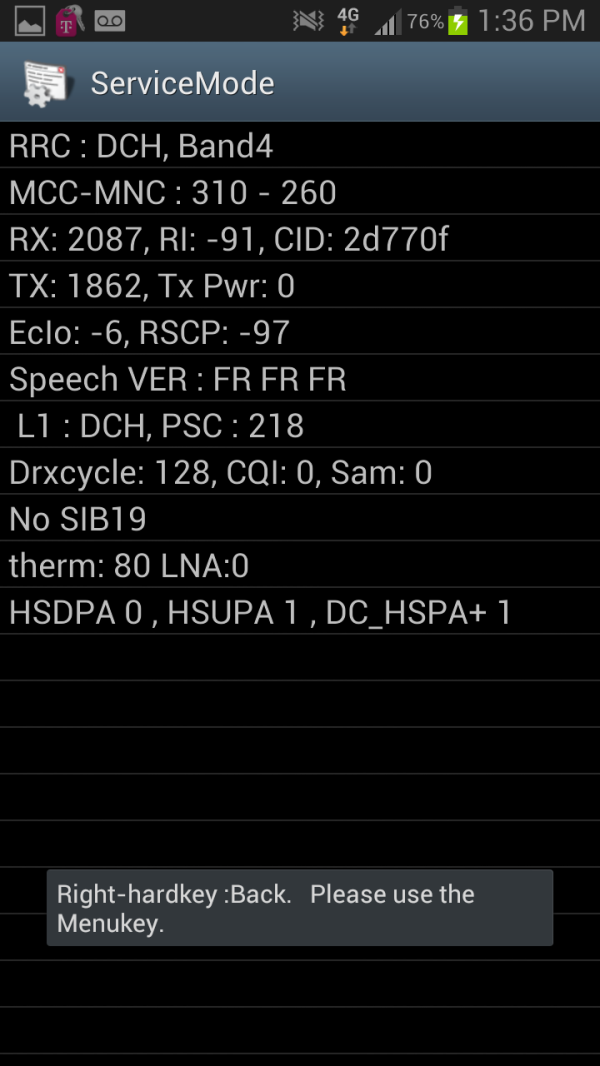
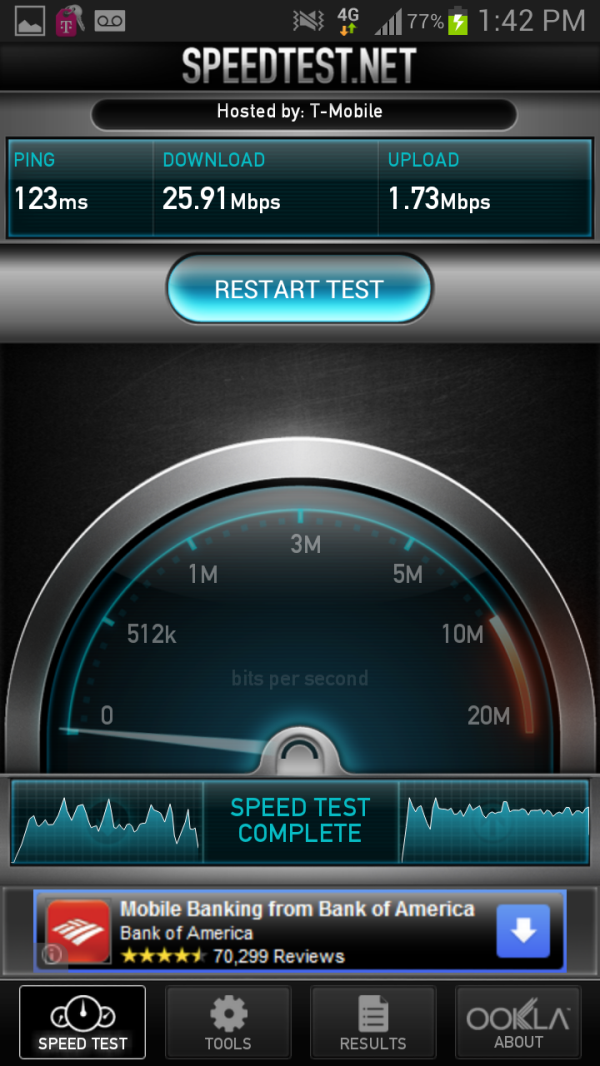
ServiceMode showing DC_HSPA+=1 (left), One of my fastest T-Mobile Tests (right)
As usual Samsung’s awesome ServiceMode is on the device and confirms that T-Mobile DC-HSPA+ is working. If you haven’t read discussion of DC-HSPA+ before, this is WCDMA carrier aggregation that combines two 5 MHz WCDMA downlink carriers, statistically multiplexes across them, and effectively doubles throughput on the downlink. That gets you from the theoretical maximum of 21.1 Mbps on 64QAM WCDMA up to 42 Mbps on dual carrier at the moment, which T-Mobile does run in its “4G” markets at present. I’m actually a huge fan of T-Mobile’s commitment to continually rolling out the latest physical layer upgrades for WCDMA and DC-HSPA+ keeps things feeling very speedy when you’re in good coverage and still helps at cell edge. Upstream is still limited to a single WCDMA uplink carrier, but most mobile traffic is so asymmetric to begin with it isn’t a huge deal.
| Galaxy Note 2 T-Mobile - Network Support | |||||
| GSM/EDGE Support | 850 / 900 / 1800 / 1900 MHz | ||||
| UMTS/WCDMA Support | 850 / 1700 / 1900 / 2100 MHz | ||||
| HSDPA/HSUPA Speeds | 42.2 Mbps (DC-HSPA+ Rel9) / 5.76 Mbps | ||||
| LTE Support | Band 17 (700 Lower B+C), 4 (AWS), UE Cat 3 FDD-LTE (Up to 100 Mbps DL) | ||||
| Baseband Hardware | Qualcomm MDM9215 (confirmed) + RTR8600 (?) | ||||
Interestingly enough ServiceMode has some hints about there being possibly even more bands, but these are probably for other Galaxy Note 2 variants based on MDM9215 that will pop up or have popped up for other locales.
Running speedtests and outputting the results on the Galaxy Note 2 is more of just a sanity check than something very interesting since we’ve seen dual carrier HSPA+ before. I had to test partially in Dallas, Texas during the Big Android BBQ and partially at home. For whatever reason the conference venue definitely had some T-Mobile propagation issues or loading from all the attendees, but the averages are still decent. I’ve seen speeds around 25 Mbps down on T-Mobile dual carrier HSPA+ which is pretty impressive honestly.
Stats Download Throughput (Mbps)Avg: 8.65, Max: 26.53, Min: 0.10, StDev: 5.60Stats Upload Throughput (Mbps)Avg: 1.49, Max: 3.56, Min: 0.01, StDev: 0.71Stats Latency (ms)Avg: 416.30, Max: 2394.00, Min: 57.00, StDev: 563.20
We see a weird double distribution of latency as well since there’s some additional setup and negotiation. I suspect getting out of PCH and into DCH results in some of this T-Mobile behavior when using speedtest.net, because tests without letting the radio go into IDLE have very low follow-up latency.
WiFi
The Note 2 uses BCM4334 for WiFi and is enabled for both 2.4 and 5 GHz. Just like the Galaxy S 3 that means 40 MHz channels on 5 GHz for a maximum physical layer speed of 150 Mbps. I did have some weird issues here, no matter what I did I couldn’t get the Note 2 to go on the 5 GHz AP, or get up to 150 Mbps.
Curiously enough there isn’t any 2.4 or 5 GHz priority toggle under the advanced tab in WiFi settings, yet the Galaxy S 3 models have this toggle and the same WiFi hardware stack. I suspect there’s some software or configuration issue here.
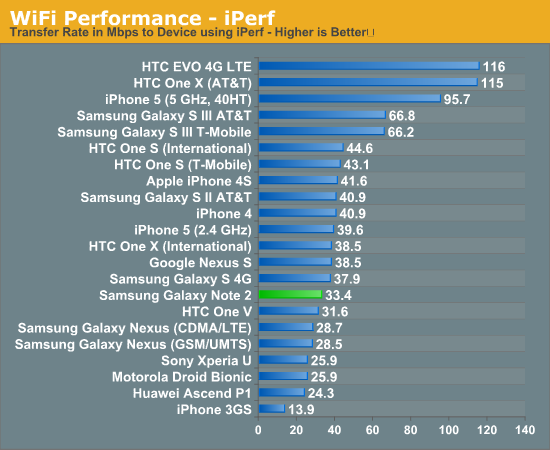
As a result we see iPerf performance out of the Galaxy Note 2 along the lines of what you’d expect for just 2.4 GHz operation. I’m puzzled as to why this is the case quite honestly.
GNSS
There’s not really too much to say about GNSS on the Galaxy Note 2 other than that like other MDM9x15 based handsets, it leverages Qualcomm’s on-baseband GpsOneGen 8A for both GPS and Russian GLONASS based positioning. Gen 8A includes better LTE coexistence and lower power consumption compared to 8. I tested GNSS and found that locks are speedy and accurate, as expected. I suspect that the days of Samsung phones shipping with flakey GPS are now well behind us.










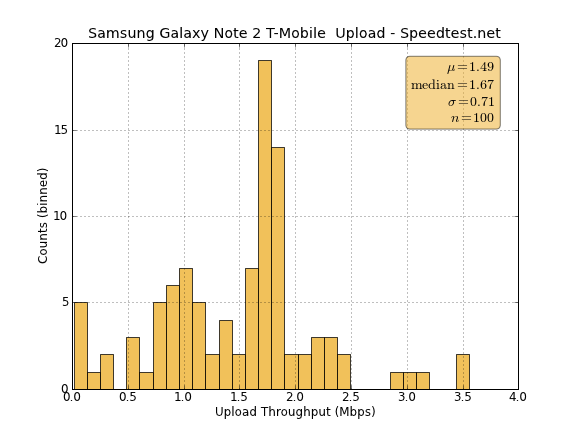
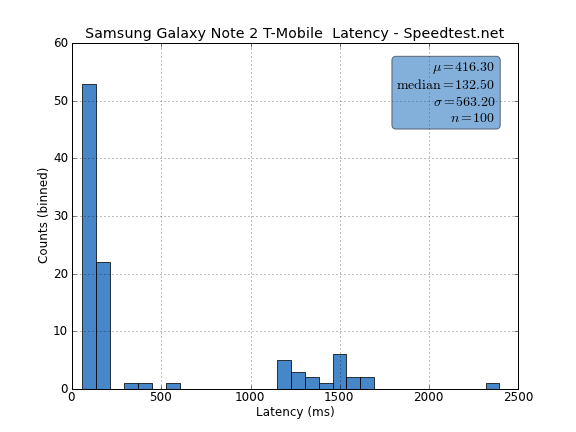
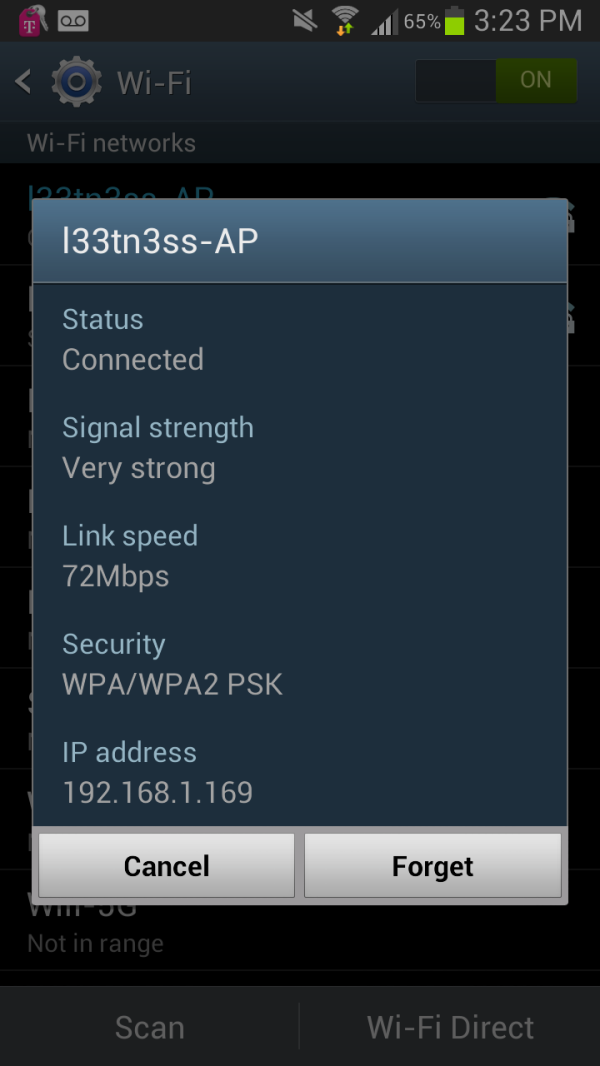
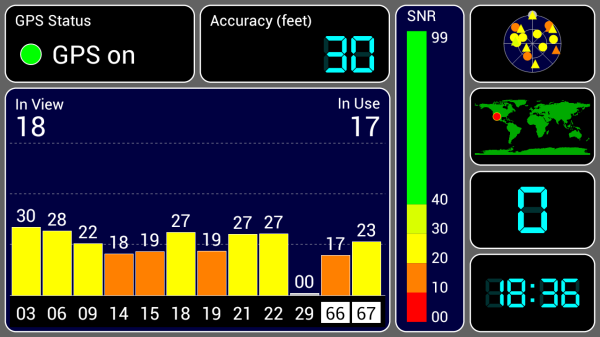








131 Comments
View All Comments
Zoomer - Wednesday, October 24, 2012 - link
Google play music actually seems to do burst caching.Peanutsrevenge - Wednesday, October 24, 2012 - link
Agreed.I listen to the cricket on tunein radio when it's on and that's a constant stream I believe and it annihilates my battery, despite the low bitrate.
Would be nice if somewhere along the line radios could go into a low power mode where it's only running close to the minimum required speed with the power taking a relative drop.
tommo123 - Wednesday, October 24, 2012 - link
and haven't got the thing below 30% in battery life yet, even after using bluetooth audio for a few hours and tracking my location with endomondo, watching movies via 3G (didn't go for the LTE ver here - no point) and so on.got my USB OTG adapter today and am seeing how long i can play movies off of it for. max brightness and playing off an SD card connected externally.
the screen on this thing is amazing and now my SGS2 is tiny, like a kids toy.
tommo123 - Wednesday, October 24, 2012 - link
well video playback laster 8 hours 19 mins with screen on max brightness, with wifi on and powering a usb OTG cable, a sd card/usb adapter and the SD card itself. now on 5%not too shabby.
in airplane mode etc and an internal mSD card i think it could hit the 10 hours mark - especially with brightness lowered a tad
Spunjji - Wednesday, October 24, 2012 - link
Pretty much fits my experience! Fairly sure there are even gains to be had from rooting, tweaking etc.tommo123 - Wednesday, October 24, 2012 - link
oh i rooted mine on the 2nd day and flashed a rom on the 3rd :)PeteH - Thursday, October 25, 2012 - link
So maybe not the best example of a "typical" user's experience ;)tommo123 - Friday, October 26, 2012 - link
nope :)i did my own test yest though
i let 720p vids play non stop yest on this in airplane mode, max brightness (like i was on a plane) and was impressed! played for 11 hours 38 mins before it hit 5%. so say 12 hours video playback.
nice.no need for a laptop to play vids on a flight anymore. just this and a spare battery for when i get off the plane :)
plus 1 for removable batteries! :D
Peanutsrevenge - Wednesday, October 24, 2012 - link
No point in LTE?You may regret that soon, 4G's rolling out as we speak.
Was in T-mo store the other day helping mate choose a phone (got S3 i9305, could convince him to get note II) and sales advisor reckons 6 months for Bournemouth.
Spunjji - Thursday, October 25, 2012 - link
This one does vary a lot by where you live. Their definition of "coverage" might be interesting too, given how their standard network holds up.